Adaptation of Conformable Residual Power Series Scheme in Solving Nonlinear Fractional Quantum Mechanics Problems
Abstract
1. Introduction
2. Notations and Preliminaries
- (1)
- , .
- (2)
- , is a constant.
- (3)
- (4)
- ,
- (5)
- Ifis differentiable, then.
3. The Conformable RPS Approach
4. Physical Numerical Applications
5. Conclusions
Author Contributions
Funding
Conflicts of Interest
Appendix A
| Absolute Error | Relative Error | Absolute Error | Relative Error | |
|---|---|---|---|---|
| 𝓋(x,t) | ti | Exact | CRPS | Absolute Error | CRPS | ||
| α = 0.9 | α = 0.8 | α = 0.7 | |||||
| 0.1 | 0.980067 | 0.980067 | 1.37972 × 10−9 | 0.971366 | 0.955893 | 0.926785 | |
| 0.3 | 0.921061 | 0.921062 | 1.00150 × 10−6 | 0.888847 | 0.838066 | 0.755156 | |
| 0.5 | 0.825336 | 0.825357 | 2.13426 × 10−5 | 0.767839 | 0.683914 | 0.558152 | |
| 0.7 | 0.696707 | 0.696866 | 1.59550 × 10−4 | 0.617253 | 0.507404 | 0.352798 | |
| 0.9 | 0.540302 | 0.541017 | 7.14529 × 10−4 | 0.445556 | 0.319365 | 0.150472 | |
| 𝓌(x,t) | ti | Exact | CRPS | Absolute Error | CRPS | ||
| α = 0.9 | α = 0.8 | α = 0.7 | |||||
Appendix B
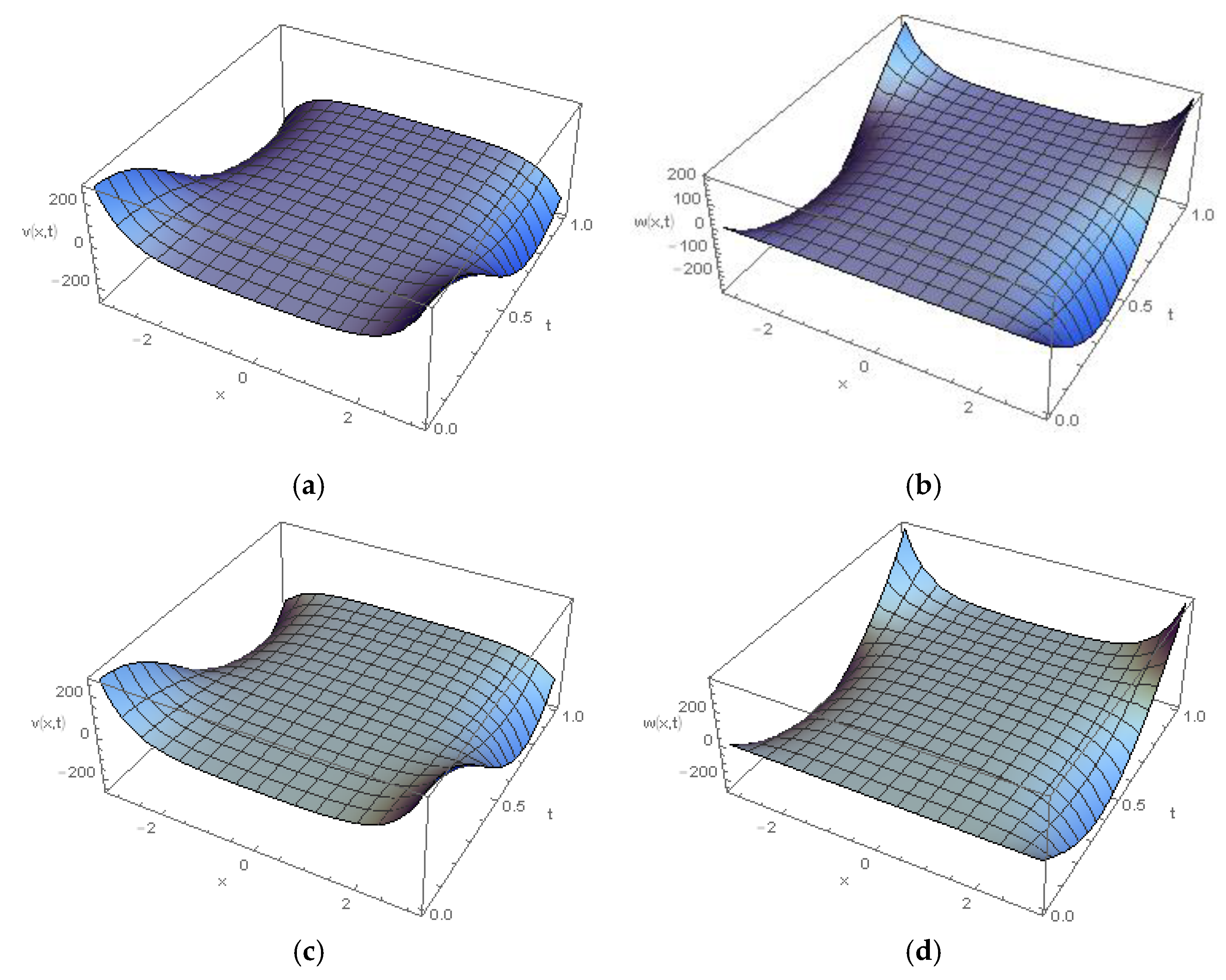
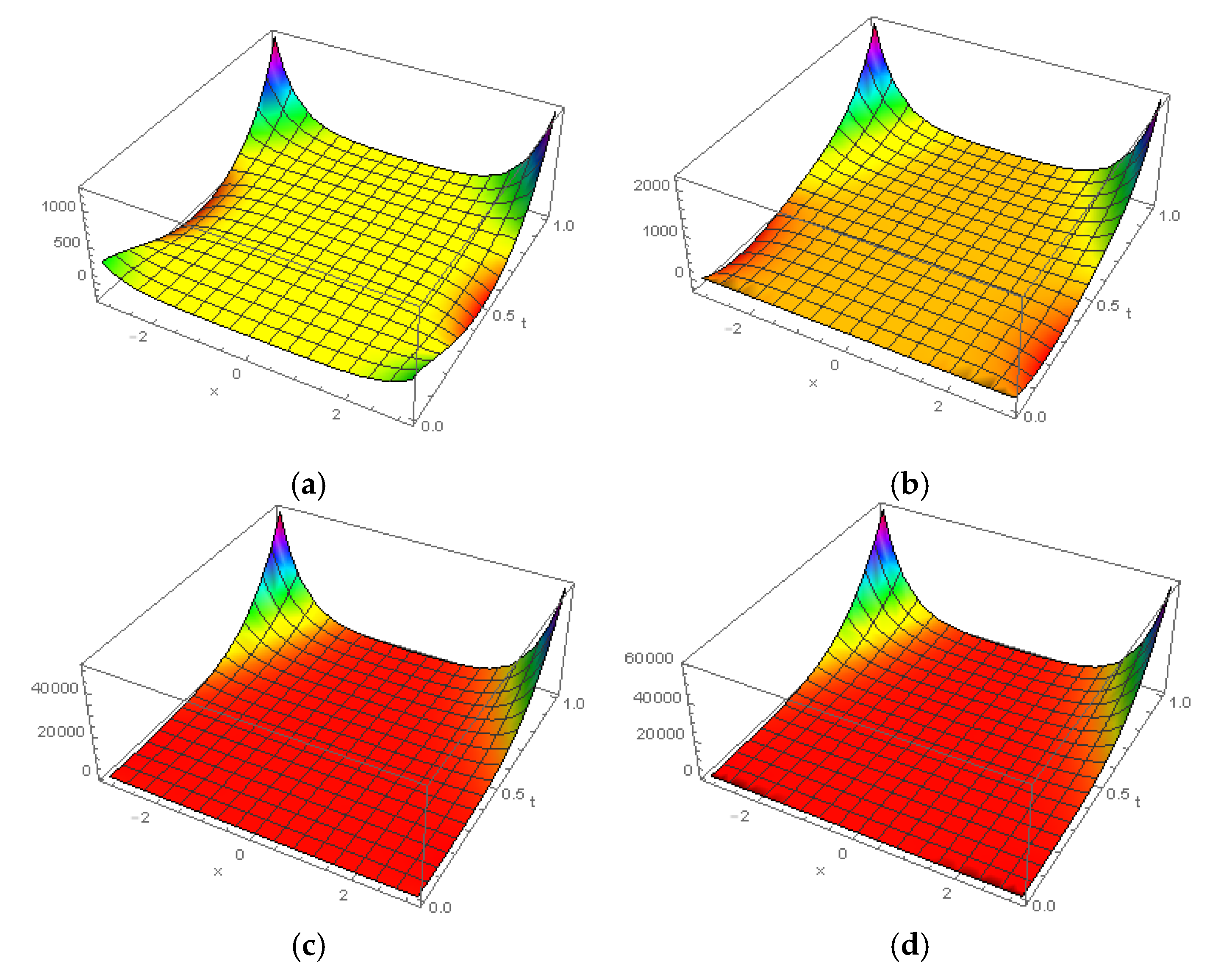
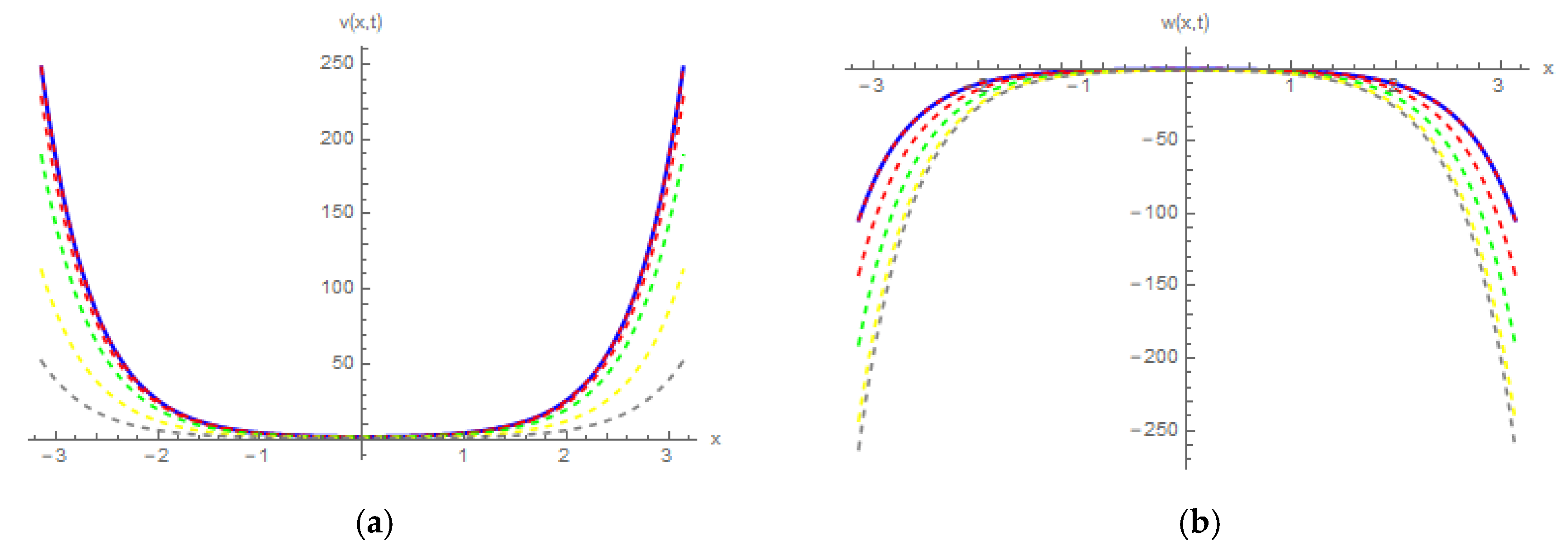

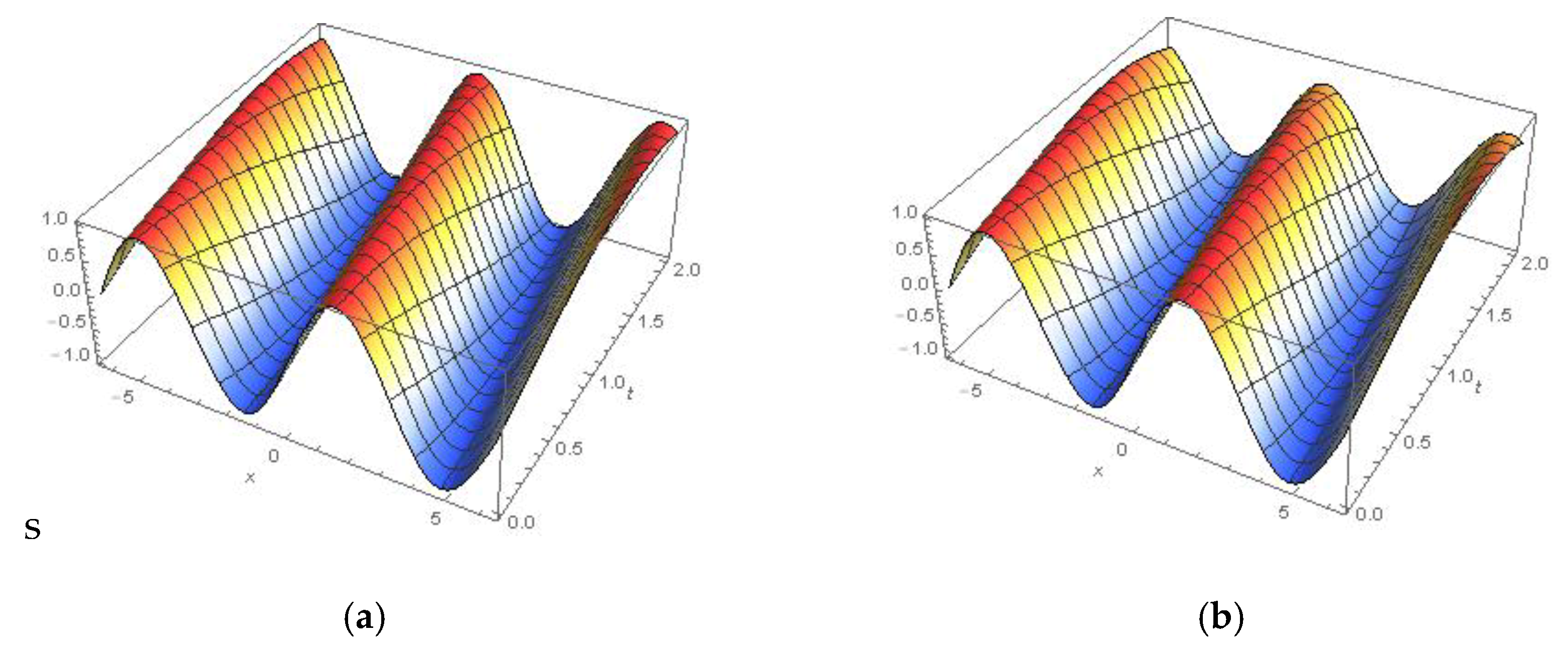

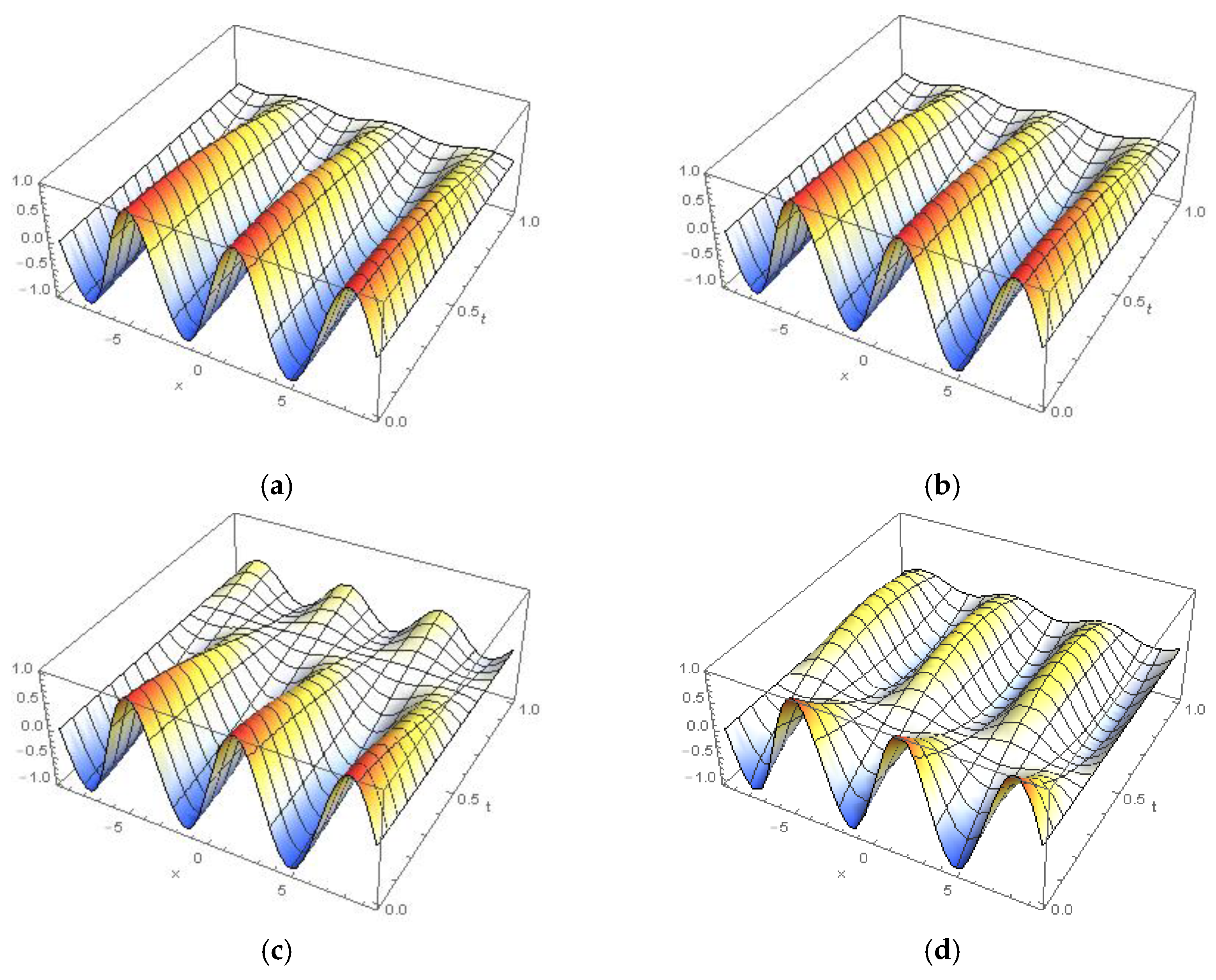
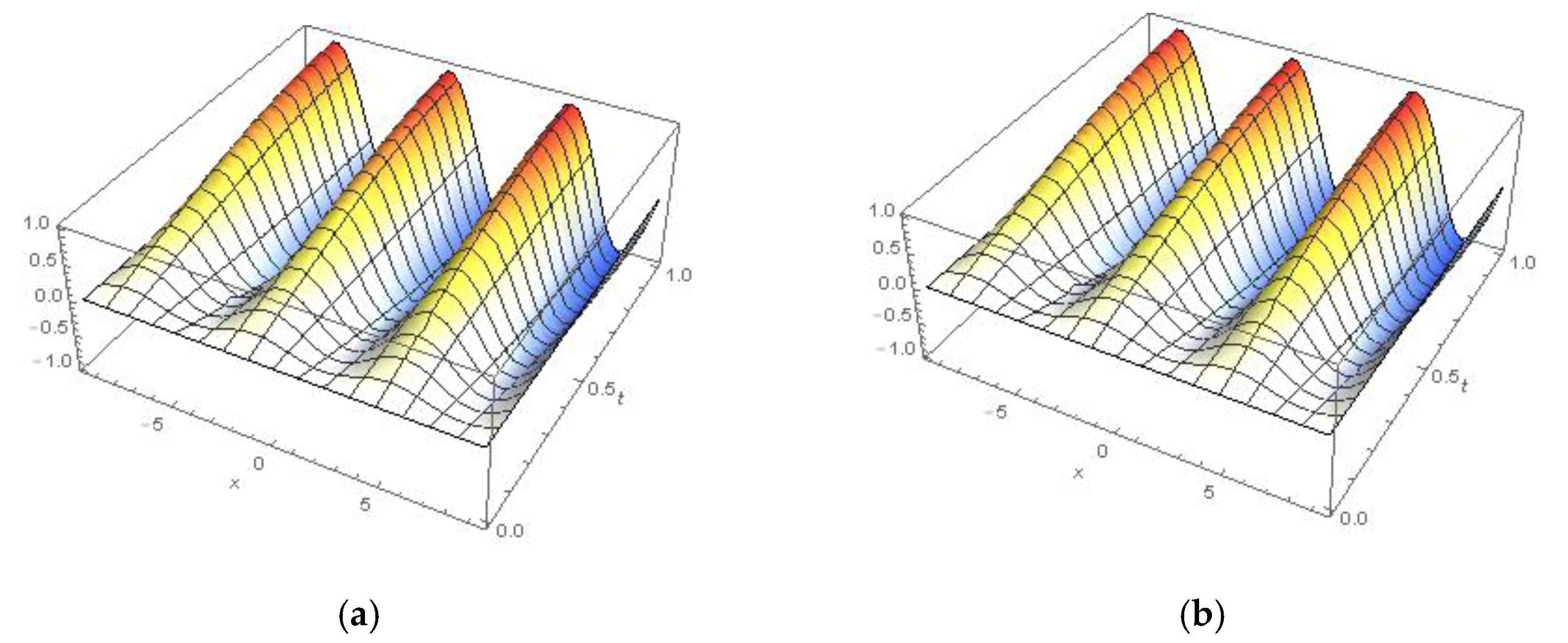
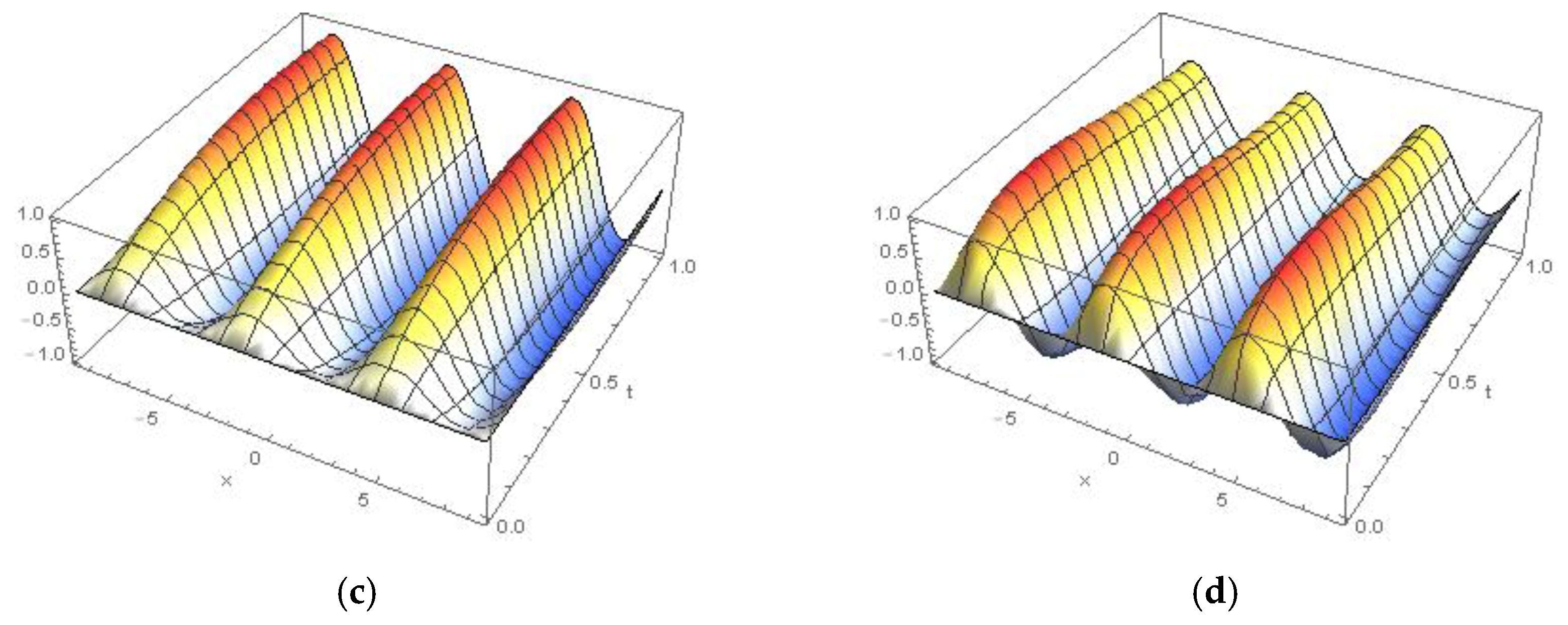
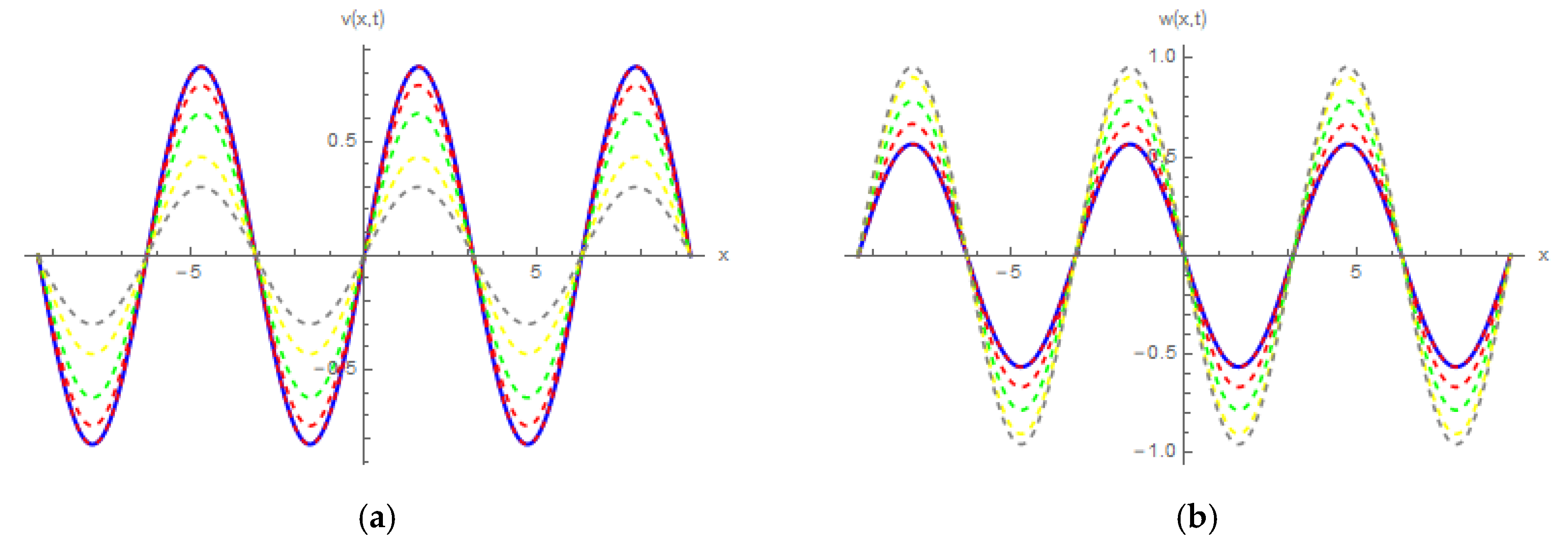
References
- Griffiths, D.; Schroeter, D. Introduction to Quantum Mechanics, 3rd ed.; Cambridge University Press: Cambridge, UK, 2018; ISBN 9781316995433. [Google Scholar]
- Eleuch, H.; Rostovtsev, Y.V.; Scully, M.O. New analytic solution of Schrödinger’s equation. EPL (Europhys. Lett.) 2010, 89, 50004. [Google Scholar] [CrossRef]
- Jha, P.K.; Eleuch, H.; Rostovtsev, Y.V. Analytical solution to position dependent mass Schrödinger equation. J. Mod. Opt. 2011, 58, 652–656. [Google Scholar] [CrossRef]
- Eleuch, H.; Rostovtsev, Y.V. Analytical solution for 3D stationary Schrödinger equation: Implementation of Huygens’ principle for matter waves. J. Mod. Opt. 2010, 57, 1877–1881. [Google Scholar] [CrossRef]
- Laskin, N. Fractional Quantum Mechanics; World Scientific Publishing Co. Pte. Ltd.: Singapore, 2018. [Google Scholar]
- Kilbas, A.A.; Srivastava, H.M.; Trujillo, J.J. Theory and Applications of Fractional Differential Equations, 1st ed.; Elsevier: Amsterdam, The Netherlands, 2010; p. 523. ISBN 100444518320. [Google Scholar]
- Shqair, M. Solution of different geometries reflected reactors neutron diffusion equation using the homotopy perturbation method. Results Phys. 2019, 12, 61–66. [Google Scholar] [CrossRef]
- Momani, S.; Abu Arqub, O.; Freihat, A.; Al-Smadi, M. Analytical approximations for Fokker-Planck equations of fractional order in multistep schemes. Appl. Comput. Math. 2016, 15, 319–330. [Google Scholar]
- Nairat, M.; Shqair, M.; Alhalholy, T. Cylindrically Symmetric Fractional Helmholtz Equation. Applied Mathematics E-Notes 2019. In press.
- Shqair, M. Developing a new approaching technique of homotopy perturbation method to solve two-group reflected cylindrical reactor. Results Phys. 2019, 12, 1880–1887. [Google Scholar] [CrossRef]
- Arqub, O.A.; Al-Smadi, M. Numerical algorithm for solving time-fractional partial integrodifferential equations subject to initial and Dirichlet boundary conditions. Numer. Methods Partial Differ. Equ. 2018, 34, 1577–1597. [Google Scholar] [CrossRef]
- Al-Smadi, M.; Abu Arqub, O. Computational algorithm for solving fredholm time-fractional partial integrodifferential equations of dirichlet functions type with error estimates. Appl. Math. Comput. 2019, 342, 280–294. [Google Scholar] [CrossRef]
- Baleanu, D.; Machado, J.A.T.; Luo, A.C. Fractional Dynamics and Control; Springer: Berlin, Germany, 2012. [Google Scholar]
- Al-Smadi, M.; Freihat, A.; Khalil, H.; Momani, S.; Khan, R.A. Numerical multistep approach for solving fractional partial differential equations. Int. J. Comput. Methods 2017, 14, 1750029. [Google Scholar] [CrossRef]
- Hasan, S.; El-Ajou, A.; Hadid, S.; Al-Smadi, M.; Momani, S. Atangana-Baleanu fractional framework of reproducing kernel technique in solving fractional population dynamics system. Chaos Solitons Fractals 2020, 133, 109624. [Google Scholar] [CrossRef]
- Al-Smadi, M. Simplified iterative reproducing kernel method for handling time-fractional BVPs with error estimation. Ain Shams Eng. J. 2018, 9, 2517–2525. [Google Scholar] [CrossRef]
- Altawallbeh, Z.; Al-Smadi, M.; Komashynska, I.; Ateiwi, A. Numerical solutions of fractional systems of two-point BVPs by using the iterative reproducing kernel algorithm. Ukrainian Math. J. 2018, 70, 687–701. [Google Scholar] [CrossRef]
- Abu Arqub, O.; Odibat, Z.; Al-Smadi, M. Numerical solutions of time-fractional partial integrodifferential equations of Robin functions types in Hilbert space with error bounds and error estimates. Nonlinear Dyn. 2018, 94, 1819–1834. [Google Scholar] [CrossRef]
- Momani, S.; Freihat, A.; Al-Smadi, M. Analytical study of fractional-order multiple chaotic Fitzhugh-Nagumo neurons model using multistep generalized differential transform method. Abst. Appl. Analy. 2014, 2014, 276279. [Google Scholar] [CrossRef] [PubMed]
- Al-Smadi, M.; Freihat, A.; Abu Arqub, O.; Shawagfeh, N. A novel multistep generalized differential transform method for solving fractional-order Lü chaotic and hyperchaotic systems. J. Comput. Analy. Appl. 2015, 19, 713–724. [Google Scholar]
- Saadeh, R.; Alaroud, M.; Al-Smadi, M.; Ahmad, R.R.; Salma Din, U.K. Application of fractional residual power series algorithm to solve Newell–Whitehead–Segel equation of fractional order. Symmetry 2019, 11, 1431. [Google Scholar] [CrossRef]
- Freihet, A.; Hasan, S.; Al-Smadi, M.; Gaith, M.; Momani, S. Construction of fractional power series solutions to fractional stiff system using residual functions algorithm. Adv. Differ. Equ. 2019, 2019, 95. [Google Scholar] [CrossRef]
- Freihet, A.; Hasan, S.; Alaroud, M.; Al-Smadi, M.; Ahmad, R.R.; Din, S.K.U. Toward computational algorithm for time-fractional Fokker-Planck models. Adv. Mech. Eng. 2019, 11, 1–11. [Google Scholar] [CrossRef]
- Hasan, S.; Al-Smadi, M.; Freihet, A.; Momani, S. Two computational approaches for solving a fractional obstacle system in Hilbert space. Adv. Differ. Equ. 2019, 2019, 55. [Google Scholar] [CrossRef]
- Khalil, R.; Al Horani, M.; Yousef, A.; Sababheh, M. A new definition of fractional derivative. J. Comput. Appl. Math. 2014, 264, 65–70. [Google Scholar] [CrossRef]
- Abdeljawad, T. On conformable fractional calculus. J. Comput. Appl. Math. 2015, 279, 57–66. [Google Scholar] [CrossRef]
- Anderson, D.R.; Ulness, D.J. Newly Defined Conformable Derivatives. Adv. Dyn. Syst. Appl. 2015, 10, 109–137. [Google Scholar]
- Atangana, A.; Baleanu, D.; Alsaedi, A. New properties of conformable derivative. Open Math. 2015, 13, 889–898. [Google Scholar] [CrossRef]
- Thabet, H.; Kendre, S. Analytical solutions for conformable space-time fractional partial differential equations via fractional differential transform. Chaos Soli. Fractals 2018, 109, 238–245. [Google Scholar] [CrossRef]
- Feng, Q. A new approach for seeking coefficient function solutions of conformable fractional partial differential equations based on the Jacobi elliptic equation. Chin. J. Phy. 2018, 56, 2817–2828. [Google Scholar] [CrossRef]
- Abu Arqub, O.; Al-Smadi, M. Fuzzy conformable fractional differential equations: Novel extended approach and new numerical solutions. Soft Comput. 2020. [CrossRef]
- Senol, M.; Tasbozan, O.; Kurt, A. Numerical Solutions of Fractional Burgers’ Type Equations with Conformable Derivative. Chin. J. Phy. 2019, 58, 75–84. [Google Scholar] [CrossRef]
- Zheng, Z.; Dai, H. A new fractional equivalent linearization method for nonlinear stochastic dynamic analysis. Nonlinear Dyn. 2018, 91, 1075–1084. [Google Scholar] [CrossRef]
- Yokus, A.; Gülbahar, S. Numerical Solutions with Linearization Techniques of the Fractional Harry Dym Equation. Appl. Math. Nonlinear Sci. 2019, 4, 35–42. [Google Scholar] [CrossRef]
- Cong, N.D.; Doan, T.S.; Siegmund, S.; Tuan, H.T. Linearized Asymptotic Stability for Fractional Differential Equations. Elect. J. Qualit. Theory Diff. Equat. 2016, 39, 1–13. [Google Scholar] [CrossRef]
- Shammari, M.A.; Al-Smadi, M.; Abu Arqub, O.; Hashim, I.; Alias, M.A. Adaptation of residual power series method to solve Fredholm fuzzy integro-differential equations. AIP Conf. Proceed. 2019, 2111, 020002. [Google Scholar]
- Alshammari, S.; Al-Smadi, M.; Hashim, I.; Alias, M.A. Residual Power Series Technique for Simulating Fractional Bagley–Torvik Problems Emerging in Applied Physics. Appl. Sci. 2019, 9, 5029. [Google Scholar] [CrossRef]
- Shqair, M.; El-Ajou, A.; Nairat, M. Analytical Solution for Multi-Energy Groups of Neutron Diffusion Equations by a Residual Power Series Method. Mathematics 2019, 7, 633. [Google Scholar] [CrossRef]
- Alaroud, M.; Al-Smadi, M.; Ahmad, R.R.; Salma Din, U.K. An Analytical Numerical Method for Solving Fuzzy Fractional Volterra Integro-Differential Equations. Symmetry 2019, 11, 205. [Google Scholar] [CrossRef]
- Alshammari, S.; Al-Smadi, M.; Al Shammari, M.; Hashim, I.; Alias, M.A. Advanced analytical treatment of fractional logistic equations based on residual error functions. Int. J. Differ. Equ. 2019, 2019, 7609879. [Google Scholar] [CrossRef]
- Abu Arqub, O. Application of Residual Power Series Method for the Solution of Time-fractional Schrödinger Equations in One-dimensional Space. Fundam. Inform. 2019, 166, 87–110. [Google Scholar] [CrossRef]
- Sadigi, A.; Ganji, D.D. Analytic treatment of linear and nonlinear Schrödinger equation: A study with homotopy perturbation method and Adomian decomposition method. Phys. Lett. A 2008, 372, 465–469. [Google Scholar] [CrossRef]
- Wazwaz, A.M. A study on linear and nonlinear Schrödinger equations by the variational iteration method. Chaos Solitons Fractals 2008, 37, 1136–1142. [Google Scholar] [CrossRef]
- Alomai, A.K.; Noorani, M.S.W.; Wazar, R. Explicit series solution of some linear and nonlinear Schrödinger equation via the homotopy analysis method. Comm. Nonlinear Sci. Num. Simul. 2009, 14, 1196–1207. [Google Scholar] [CrossRef]
- Baleanu, D.; Golmankhaneh, A.K.; Golmankhaneh, A.K. Solving of the fractional non-linear and linear Schrödinger equations by homotopy perturbation method. Rom. J. Phy. 2019, 54, 823–832. [Google Scholar]
- Alam Khan, N.; Jamil, M.; Ara, A. Approximate Solutions to Time-Fractional Schrödinger Equation via Homotopy Analysis Method. Int. Sch. Res. Net. 2012. [Google Scholar] [CrossRef]
© 2020 by the authors. Licensee MDPI, Basel, Switzerland. This article is an open access article distributed under the terms and conditions of the Creative Commons Attribution (CC BY) license (http://creativecommons.org/licenses/by/4.0/).
Share and Cite
Shqair, M.; Al-Smadi, M.; Momani, S.; El-Zahar, E. Adaptation of Conformable Residual Power Series Scheme in Solving Nonlinear Fractional Quantum Mechanics Problems. Appl. Sci. 2020, 10, 890. https://doi.org/10.3390/app10030890
Shqair M, Al-Smadi M, Momani S, El-Zahar E. Adaptation of Conformable Residual Power Series Scheme in Solving Nonlinear Fractional Quantum Mechanics Problems. Applied Sciences. 2020; 10(3):890. https://doi.org/10.3390/app10030890
Chicago/Turabian StyleShqair, Mohammed, Mohammed Al-Smadi, Shaher Momani, and Essam El-Zahar. 2020. "Adaptation of Conformable Residual Power Series Scheme in Solving Nonlinear Fractional Quantum Mechanics Problems" Applied Sciences 10, no. 3: 890. https://doi.org/10.3390/app10030890
APA StyleShqair, M., Al-Smadi, M., Momani, S., & El-Zahar, E. (2020). Adaptation of Conformable Residual Power Series Scheme in Solving Nonlinear Fractional Quantum Mechanics Problems. Applied Sciences, 10(3), 890. https://doi.org/10.3390/app10030890






